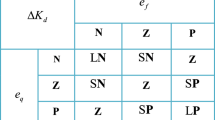Abstract
A fuzzy iterative learning control strategy for powered ankle prosthesis is presented in this paper. It is used to solve the problem which is the deviation of movement trajectory between powered ankle prosthesis and human ankle joint during walking. The powered ankle prosthesis is a nonlinear and strongly coupled complex system. Traditional fuzzy control and iterative learning control (ILC) as powered ankle prosthesis controllers have their own deficiencies. Fuzzy iterative learning control strategy integrates the two controllers’ advantages. In the initial stage of control, the fuzzy control is used. The outputs of fuzzy control as the initial value of ILC. In the next stage of control, ILC is used. The dynamic model of powered ankle prosthesis is established in this paper. Simulation results indicate that fuzzy iterative learning control strategy can substantially improve control efficient, and needs two iterations to get maximum tracking absolute error ε ≤ 1°.












Similar content being viewed by others
References
Au, S.K.W.: Powered ankle-foot prosthesis for the improvement of amputee walking economy. PhD. Dissertation, Massachusetts institute of Technology (2007)
Bai, Y., Zhuang, H., Roth, Z.S.: Fuzzy logic control to suppress noises and coupling effects in a laser tracking system. IEEE Trans. Control Syst. Technol. 13(1), 113–121 (2004)
Fleischer, C.: Controlling prosthesiss with EMG signals and a biomechanical body model. PhD. Dissertation, Technical University of Berlin (2007)
Gancet, J., Ilzkovitz, M., Motard, E., et al.: MINDWALKER: Going one step further with assistive lower limbs exoskeleton for SCI condition subjects. IEEE Ras & Embs International Conference on Biomedical robotics and biomechatronics. IEEE, pp. 1794–1800 (2012)
Han, H., Zhang, X., Mu, X.: An approach for fuzzy control of elderly-assistant and walking-assistant robot. International Conference on Ubiquitous Robots and Ambient Intelligence. IEEE, pp. 263–267 (2017)
Jia, X.G., Yuan, Z.Y.: Adaptive iterative learning control for robot manipulators. IEEE International Conference on Intelligent computing and intelligent systems, 2010:1195–1203
Lee, C.C.: Fuzzy logic in control systems: fuzzy logic controller I. IEEE Trans. Syst. Man Cybern. 20(2), 404–418 (1990)
Ngo, T.Q., Wang, Y.N., Mai, T.L., et al.: An adaptive iterative learning control for robot manipulator in task space. Int. J. Comput. Commun. Control 7(3), 518–529 (2014)
Palmer, Lars M.: Sagittal plane characterization of normal human ankle function across a range of walking gait speeds. Biotechnol. Prog. 25(6), 1819–1825 (2002)
Tang, R., Hou, L., Zhang, Q.: Adaptive iterative learning control for SCARA robot manipulators. Int. J. Adv. Comput. Technol. 4(21), 50–58 (2012)
Vallery, H., Asseldonk, E.H.F., Buss, M., Kooij, H.: Reference trajectory generation for rehabilitation robots: complementary limb motion estimation. IEEE Trans. Neural Syst. Rehabil. Eng. 17(1), 23–30 (2009)
Vaughan, C.L., Davis, B.L., Connor, J.C.O.: Dynamics of human gait, 2nd edn. Kiboho Publishers, Cape Town (2006)
Xiang, K., Yi, C., Yin, K.Y., Ge, Y.J.: An ankle exoskeleton for walking assist. J Huazhong Univ Sci Technol 43(S1), 367–371 (2015)
Yang CJ, Niu B, Chen Y.: Adaptive neuro-fuzzy control based development of a wearable prosthesis leg for human walking power augmentation. In: International Conference on Advanced intelligent mechatronics, Monterey, California, pp. 467–472 (2005)
Yeon, J.S., Park, J.H., Son, S.W., Lee, S.H.: Model-based iterative learning control for industrial robot manipulator. In: Proceedingof the IEEE Int. Conf. on automation and logistics, Shenyang, China, pp. 24–28 (2009)
Zadeh, L.A.: Fuzzy sets. Inf Control 8(3), 338–353 (1965)
Zadeh, L.A.: The concept of a linguistic variable and its application to approximate reasoning—II. Learning systems and intelligent robots. Springer US, pp. 199–249 (1974)
Zhang, J., Fiers, P., Witte, K.A., et al.: Human-in-the-loop optimization of exoskeleton assistance during walking. Science 356, 1280–1284 (2017)
Zhou, S., Feng, G., Feng, C.B.: Robust control for a class of uncertain nonlinear systems: adaptive fuzzy approach based on backstepping. Fuzzy Sets Syst. 151(1), 1–20 (2005)
Acknowledgements
This work was supported by the National Natural Science Foundation of China under Grant (61603284).
Author information
Authors and Affiliations
Corresponding author
Rights and permissions
About this article
Cite this article
Yin, K., Pang, M., Xiang, K. et al. Fuzzy iterative learning control strategy for powered ankle prosthesis. Int J Intell Robot Appl 2, 122–131 (2018). https://doi.org/10.1007/s41315-018-0047-9
Received:
Accepted:
Published:
Issue Date:
DOI: https://doi.org/10.1007/s41315-018-0047-9




